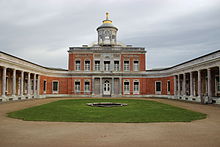Carl von Gontard
Carl Philipp Christian von Gontard (born January 13, 1731 in Mannheim ; † September 23, 1791 in Breslau ) was a German architect who worked mainly in Potsdam , Berlin and Bayreuth . In terms of architectural history, Gontard's work stands independently without successors between the Palladian Rococo Knobelsdorff and the classicism of the older and younger Gilly and her students.
Life




Carl Gontard came from the Huguenot Gontard family from the Dauphiné . His parents were Alexander von Gontard (1706–1747) and his wife Elisabeth Kurz († 1776). His father was probably the ballet master of the Electoral Palatinate in Mannheim before he became ballet master at the margravial theater in Bayreuth in 1741. Carl von Gontard also initially worked as a ballet master at the margravial opera. He was married to Sophia von Erckert (1733–1795) and had 16 children, including Carl Friedrich Ludwig von Gontard , who later became an honorary citizen of Berlin . In 1767, Emperor Joseph II raised Carl Gontard to the hereditary nobility, together with his brother, an imperial officer .
In 1749 he joined the Bayreuth court building authority as a conductor . After two years of study in Paris with Blondel and a long trip to Italy, he had already made a name for himself as the court architect of Margravine Wilhelmine von Bayreuth when, after the death of Margrave Friedrich von Brandenburg-Bayreuth in 1763, due to the austerity policy of his successor Friedrich Christian, there were hardly any more tasks . In Bayreuth he was a member of the Masonic Lodge Eleusis for Confidentiality .
Gontard entered the service of Frederick II of Prussia (brother of Wilhelmine von Bayreuth ) in 1764 , who immediately enlisted him to design the New Palace and the associated Communs , Gontard's first major work in Potsdam. Gontard's main work in Berlin, the porticoed columns and towers of the German and French cathedral , gave the Gendarmenmarkt its face. However, after the spectacular partial collapse of the German Cathedral (then: New Church) in July 1781, Georg Christian Unger took over the completion of the building. Gontard did not fall out of favor, but kept the construction management of the Royal Library , where he set up the stairwell and the great hall. He also designed and built houses in Potsdam, such as the representative street Am Bassin . He is one of the most important artists of the Frederician Rococo .
Immediately after Friedrich's death, Gontard received the order from the heir to the throne, Friedrich Wilhelm II , to decorate the parade rooms in the Potsdam City Palace and the garrison church for the funeral ceremonies . Larger royal orders followed. From 1787 to 1790 he furnished nine rooms in the royal chambers in the Berlin City Palace . At the same time he created the Marble Palace in Potsdam, one of his best works. His last work was the Dutch establishment in Potsdam's New Garden .
Works (selection)
- Town houses
- Palace complex in Bayreuth
- Numerous residential buildings in Bayreuth (e.g. Reitzenstein-Palais, court pharmacy, own residential building), Potsdam and Berlin
- Military orphanage in Potsdam
- Towers of the German and French Cathedral in Berlin
- Rosenthaler Tor in Berlin
- Colonnades in Berlin like that
- 1776 built Spittelkolonnaden and the
- Royal Colonnades built between 1777 and 1780
- Buildings in Potsdam's Sanssouci Park such as the Temple of Friendship and the Temple of Antiquities and the Marble Palace in the New Garden .
- 1787/88 Oranienburger Tor in Berlin
- 1770 City side of the Brandenburg Gate in Potsdam
- 1764/65 Evangelical Lutheran rectory in Neudrossenfeld
- 1766/68 Evangelical St. Bartholomew Church (or Trinity Church) in Bindlach together with Rudolf Heinrich Richter
literature
- Robert Dohme : Gontard, Carl von . In: Allgemeine Deutsche Biographie (ADB). Volume 9, Duncker & Humblot, Leipzig 1879, p. 368.
- Adolph Doebber : Gontard, Karl Philipp Christian von . In: Ulrich Thieme , Fred. C. Willis (Ed.): General lexicon of visual artists from antiquity to the present . Founded by Ulrich Thieme and Felix Becker . tape 14 : Giddens-Gress . EA Seemann, Leipzig 1921, p. 372–373 ( Text Archive - Internet Archive ).
- Horst Drescher : Gontard, Carl v. In: New German Biography (NDB). Volume 6, Duncker & Humblot, Berlin 1964, ISBN 3-428-00187-7 , p. 643 f. ( Digitized version ).
- Astrid Fick: Potsdam - Berlin - Bayreuth. Carl Philipp Christian von Gontard (1731–1791) and his bourgeois houses, immediate buildings and city palaces. Imhof, Petersberg 2000, ISBN 3-932526-42-2 .
- Hermann Heckmann : Builder of the Baroque and Rococo in Brandenburg-Prussia. Verlag für Bauwesen, Berlin 1998, ISBN 3-345-00631-6 , pp. 432–453.
- Hermann Schmitz: Berlin master builder from the end of the eighteenth century. 2nd Edition. E. Wasmuth, Berlin 1925, pp. 23–28 and tables pp. 96–102, 105, 108, 140/141, 143 (Unchanged reprint: Mann, Berlin 1980, ISBN 3-7861-1272-X ( Die Bauwerke und Art monuments of Berlin. Supplement 2)).
Web links
- Literature by and about Carl von Gontard in the catalog of the German National Library
- Works by Carl von Gontard at Zeno.org .
- Berliner Historische Mitte eV: City Palace - King's Chambers Friedrich. Wilhelm II. (PDF; 964 kB)
Individual evidence
- ↑ a b Horst Drescher: Gontard, Carl v. In: New German Biography (NDB). Volume 6, Duncker & Humblot, Berlin 1964, ISBN 3-428-00187-7 , p. 643 f. ( Digitized version ).
| personal data | |
|---|---|
| SURNAME | Gontard, Carl von |
| ALTERNATIVE NAMES | Gontard, Carl Philipp Christian von (full name); Gontard, Karl |
| BRIEF DESCRIPTION | German architect |
| DATE OF BIRTH | January 13, 1731 |
| PLACE OF BIRTH | Mannheim |
| DATE OF DEATH | September 23, 1791 |
| Place of death | Wroclaw |



